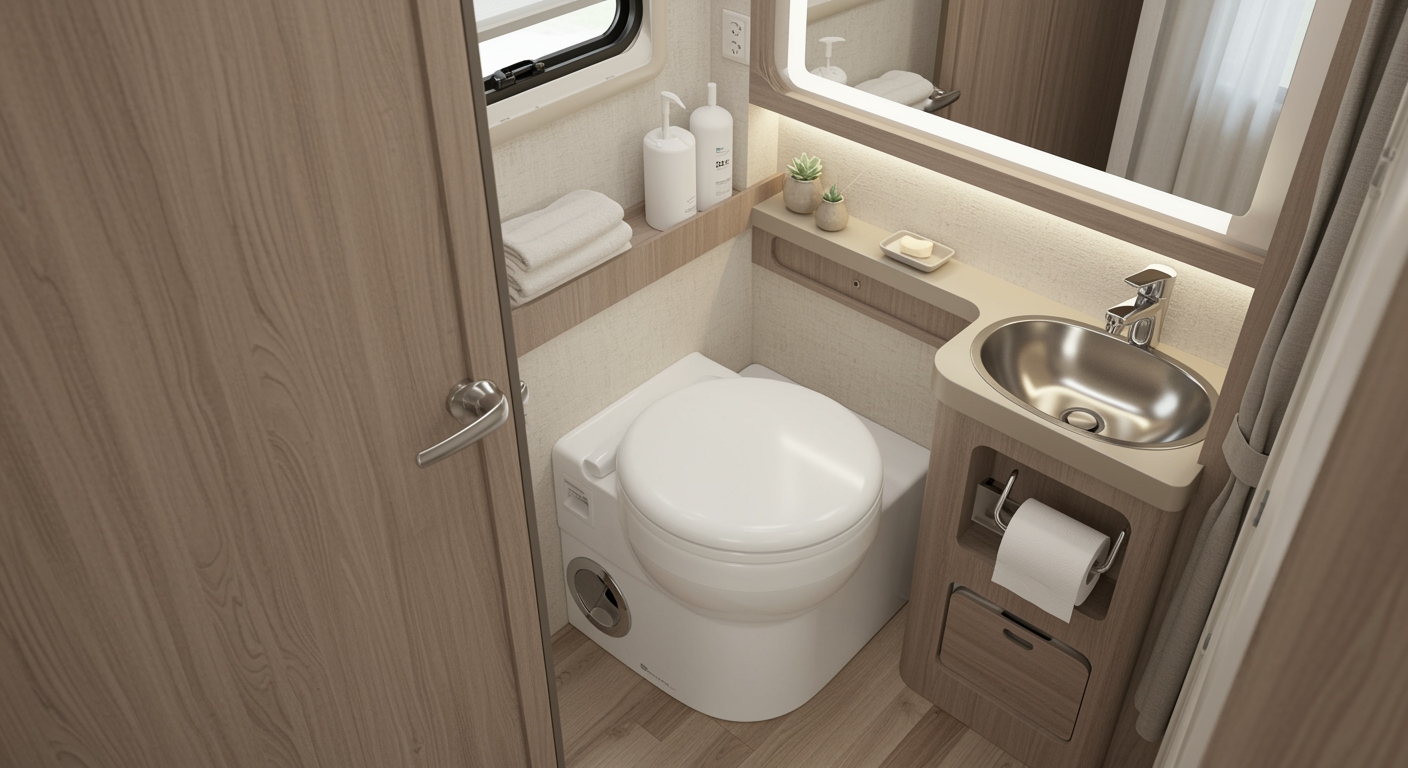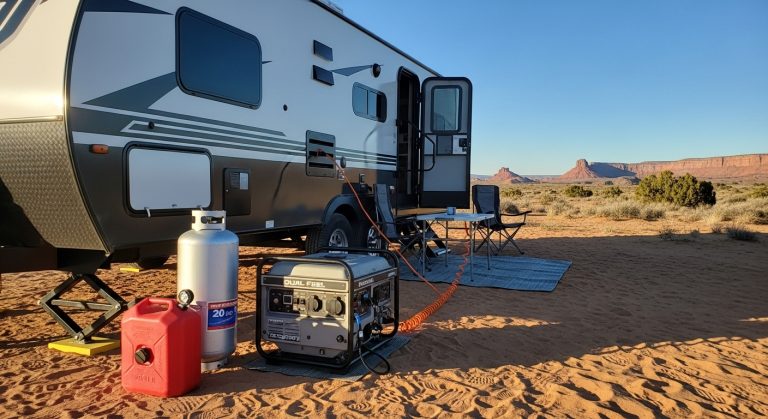If your RV toilet smells, it’s likely due to black tank gas buildup from waste decomposition or low water usage hindering breakdown. Blocked vent pipes can trap odors inside, while worn seals let gases escape. Hot weather worsens smells by speeding up anaerobic bacteria activity. Neglected cleaning or improper tank treatments also contribute. Check vents, seals, and flushing habits to tackle the issue. Stick around to uncover deeper insights into fixing this problem.
Key Takeaways
- Worn toilet seals allow black tank gases to escape into the RV.
- Insufficient water in the tank exposes solids, causing strong odors.
- Blocked vent pipes trap gases, forcing smells back into the living space.
- Buildup of waste from poor flushing creates odor-emitting mounds.
- Hot weather accelerates decomposition, worsening smells with anaerobic bacteria.
Black Tank Odor Sources
The black tank in your RV can be a major source of unpleasant odors, often stemming from a few key issues.
Worn toilet seals, like the bowl or flange gasket, let water drain and allow tank gases to escape into your rig. Insufficient water in the tank exposes solids, intensifying smells, while also hindering beneficial bacteria from breaking down waste odorlessly.
Buildup or pyramiding of solids, especially from poor flushing habits, creates mounds above the water line, emitting strong odors. To further reduce odors, regular vent system maintenance can help prevent issues like clogged vents that trap gases. A clogged vent pipe can also trap gases, forcing them back into the RV during flushing clogged vent pipe.
Improper tank treatments can kill good bacteria or merely mask smells without addressing the source. High temperatures accelerate decomposition by anaerobic bacteria, evaporate water, and make odors more potent. Tackle these issues with regular maintenance and proper water levels.
Vent Pipe Blockages
If you’re noticing foul sewer odors inside your RV or hearing odd gurgling and burping from the toilet when flushing, you’ve likely got a blocked vent pipe trapping gases.
Don’t ignore these signs; start by inspecting the roof vent for visible debris or nests and prepare to clear the obstruction.
You can use a garden hose or a plumber’s snake to flush or dislodge blockages, getting that critical airflow restored to banish the stench. For comprehensive maintenance, incorporating vinegar solution methods can help address related odor issues in your RV’s plumbing.
A blocked vent pipe can also lead to slow draining in your RV’s plumbing system slow draining issues.
Vent Blockage Symptoms
Many RV owners overlook vent pipe blockages until a persistent, foul odor creeps into the living space, signaling a serious issue with the plumbing system.
You’ll likely notice a strong, rotten egg smell, especially when flushing the toilet, as sewer gases like hydrogen sulfide infiltrate your RV.
Check for gurgling noises from drains or the toilet, and watch for bubbling or splashing during flushes due to pressure buildup.
Your black tank might drain slowly or not at all, and the toilet bowl may not hold water, indicating a bad seal.
If you hear air sucking sounds or notice slow draining in sinks and showers, suspect a vent blockage.
Additionally, a clogged vent can cause water to take a long time to drain from multiple fixtures, exacerbating the problem across your RV’s plumbing system clogged vent causes.
Regular maintenance, such as emptying holding tanks during winterization, can help mitigate these odor issues and prevent further complications.
These symptoms demand immediate attention to prevent further damage.
Clearing Pipe Obstructions
Spotting symptoms of a vent blockage means it’s time to roll up your sleeves and tackle the problem head-on.
Start by safely accessing the RV roof with a stable ladder and proper footwear.
Remove the vent cap with a screwdriver, inspecting the opening with a flashlight for debris like leaves or nests.
Use a garden hose with a high-pressure nozzle to flush out loose material; if water backs up, the clog’s deeper.
Try a plumber’s snake from the roof, cranking to break up obstructions, and pull out debris.
For stubborn blockages, consider high-pressure jetting tools or RV-safe chemical treatments.
Be aware that sewer odors from a clogged vent can infiltrate your living space and pose health risks sewer odors infiltrate.
After clearing, flush with water to confirm flow and reseal the cap with caulk if needed. Additionally, to ensure long-term roof integrity, consider roof sealing every 1-4 years based on your RV’s material and usage.
Toilet Seal Breakdowns
When you’re troubleshooting why your RV toilet smells, start by inspecting the bowl seal for failures that let black tank odors escape into your living space.
Next, check for flange seal leaks at the base, as cracks or wear here can cause water to seep out and stink up the area after flushing.
If you spot visible damage or smell sewer gases, you’ve likely got a seal issue needing immediate attention.
Additionally, ensure there’s enough water in the bowl, as insufficient levels can allow sewer gas escape.
To maintain your RV’s seals effectively, consider performing regular inspections every few months to catch potential problems early.
Bowl Seal Failures
If you’re noticing a persistent foul odor in your RV bathroom, the culprit might be a failing bowl seal in your toilet.
This rubber gasket around the flush valve holds water in the bowl, blocking black tank smells.
When it dries out, cracks, or gets debris like toilet paper or limescale underneath, it can’t seal properly, letting odors escape.
Check for water loss in the bowl or visible cracks on the seal.
To maintain it, apply silicone-based RV toilet lubricant regularly and keep water in the bowl during use.
Clean gently with mild detergent and a soft brush. Regular lubrication, at least once a year, helps prevent seal drying and ensures a proper barrier against odors.
If damage persists, replace the seal using the correct part for your toilet model after draining and disassembling.
Flange Seal Leaks
Ever wonder why a stubborn sewer smell lingers near your RV toilet, even when the bowl holds water? You’re likely dealing with a flange seal leak.
This critical seal, located beneath your toilet base, connects it to the black tank pipe, preventing sewer gases from escaping.
Made of rubber or foam, it can degrade over time, crack from age, or fail due to improper installation, loose bolts, or RV vibrations.
Check for signs like persistent odors, water pooling at the base, or a wobbly toilet. If confirmed, you’ll need to remove the toilet, clean the area, and install a compatible OEM seal. Secure the mounting bolts evenly—don’t overtighten—and inspect stability regularly to avoid future leaks. Just as with other RV components, regular inspections every few months can help catch seal issues early. Regular lubrication of seals can also help prevent gas leaks and extend their lifespan.
Low Water Usage Impact
How does low water usage turn your RV toilet into a source of unpleasant odors? When you skimp on water, solid waste doesn’t flush properly, building up as “poop pyramids” under the toilet line.
This lack of liquid hinders waste breakdown, compacts the tank, and exposes solids to air, releasing strong odors.
Low water also weakens the odor barrier in the bowl, letting tank gases seep into your living space.
Moreover, insufficient water impairs beneficial bacteria that digest waste, favoring odor-causing anaerobic bacteria instead.
Flushing with minimal water or holding the pedal too briefly fails to clear solids, worsening pile-up.
During dumping, low liquid levels prevent thorough emptying, leaving residual waste to stink up your RV.
To prevent this, ensure you flush for at least 10 seconds to create adequate water barrier.
Hot Weather Challenges
Building on the issue of low water usage, let’s explore how hot weather amplifies RV toilet odors with its own set of challenges.
When temperatures climb above 85-90°F, anaerobic bacteria in your black tank thrive, rapidly breaking down waste and releasing potent hydrogen sulfide and methane gases.
Heat vaporizes odor molecules, making smells stronger, while humidity keeps them lingering. To improve air circulation and reduce odors, consider using a heater with wide oscillation.
Additionally, high heat cripples enzyme and aerobic bacteria treatments, letting odor-causing bacteria dominate.
Water in your tank and toilet bowl seal evaporates faster, exposing waste and allowing gases to escape into your RV.
Expanding tank gases increase pressure, and if vents are clogged or ineffective, odors can backflow through seals or plumbing.
Hot weather demands vigilant tank management to curb these issues, and maintaining adequate water levels is crucial to prevent waste from rising above the water line prevent waste exposure.
Cleaning Routine Gaps
Have you considered the impact of inconsistent cleaning on your RV toilet’s odor issues?
Neglecting regular cleaning lets waste buildup and bacteria thrive, especially in plastic bowls, causing persistent smells throughout your RV.
Ignoring routine cleaning allows waste and bacteria to flourish in plastic RV toilet bowls, leading to lingering odors that spread throughout your space.
You’ve gotta scrub beyond visible surfaces—rim holes and under the seat harbor residue if ignored.
Don’t skip deep cleaning; hidden debris accumulates without periodic disassembly of components like gaskets per manufacturer guidelines.
Use RV-specific, chemical-free cleaners to avoid damaging parts or killing beneficial bacteria with harsh abrasives or bleach.
Check the toilet seal too—gases escape if it’s dry or damaged, ruining the vapor barrier.
Flush with ample water to prevent pipe residue.
Consistent, thorough cleaning is your first defense against stubborn odors.
Regular cleaning also prevents buildup and odors over time.
Just as you maintain your RV’s exterior, applying high gloss polish can enhance overall vehicle protection and appearance.
Tank Treatment Choices
Ever wondered why your RV toilet odor persists despite regular cleaning? The culprit often lies in your tank treatment choice. You’ve got options like chemical, enzyme, bacteria/microbial, and mineral salt treatments, each tackling waste and odor differently.
Older chemical treatments, often formaldehyde-based, kill all bacteria and mask smells but harm septic systems.
Enzyme treatments break down waste fast with proteins like amylase and lipase, though odor control might lag.
Bacteria/microbial options, like Unique RV Digest-It, introduce beneficial aerobic bacteria to outcompete odor-causing ones, excelling in waste liquefaction and eco-friendliness, but they need proper water and temperature.
Mineral salts, using compounds like zinc sulfate, focus on odor control. Recent regulations, like California Senate Bill 317, have pushed manufacturers to reformulate products for safer, eco-friendly alternatives.
Choose wisely based on your RV’s needs and environmental impact.
Maintenance Best Practices
How can you keep RV toilet odors at bay with proper care?
Regular maintenance of your RV toilet system prevents smells from taking over.
With a precise approach, you’ll guarantee a fresh, functional setup by tackling key areas. For comprehensive RV care, also consider maintaining your water supply with heated water hoses to ensure a steady flow of clean water.
Here’s how to maintain your system effectively:
- Flush Smart: Use ample water (1/3 to 1/2 bowl) for solids, pre-fill before use, and execute a full, quick flush to avoid residue.
- Clean Safely: Use RV-safe, eco-friendly cleaners and soft brushes; rinse after each use to stop odor-causing buildup.
- Seal Care: Inspect and lubricate seals annually with silicone lubricant, replacing any cracked or dry ones.
- Tank Management: Keep the black tank valve closed until dumping, flush regularly, and add water post-dump to prevent drying.
- Vent Check: Routinely inspect the sewer vent on the roof for blockages to ensure proper gas escape.
Frequently Asked Questions
Can RV Toilet Odors Affect My Health?
Hey, you’ve gotta know that RV toilet odors can indeed impact your health.
These smells often signal sewer gases like hydrogen sulfide, which, even at low levels, irritate eyes, nose, and throat, causing headaches or nausea.
Higher exposure risks severe respiratory issues or unconsciousness.
Chronic exposure might lead to fatigue or memory issues.
Plus, bacteria and mold from black water can trigger serious illnesses.
Stay vigilant and address odors promptly!
Why Does the Smell Worsen at Night?
Hey, ever notice how those unpleasant whiffs in your RV seem to intensify under the cover of night?
You’re not imagining it.
Cooler evening air gets denser, trapping gases near your rig.
Reduced ventilation from still air and inactive fans lets odors settle.
Plus, anaerobic bacteria keep working in the warm tank, producing more stench.
Without overnight flushes, gas builds up, making the aroma downright aggressive after dark.
Could Nearby RVS Cause My Odor Issues?
Hey, let’s tackle if nearby RVs could be behind your odor troubles.
You’ve gotta consider their black tank vents on the roof—wind can push those nasty gases like hydrogen sulfide right toward your rig.
If your windows or ceiling vents are open, you’re inviting those smells inside.
Plus, poor neighbor maintenance or dump station proximity can worsen it.
Check vent positions and keep openings shut when possible.
Does Altitude Impact RV Toilet Smells?
Think of altitude as a sneaky thief, slipping through the cracks of your RV’s plumbing defenses.
You’ll notice that higher elevations lower atmospheric pressure, messing with vent function.
This can push sewer gases back inside if venting isn’t spot-on.
Check your roof vent for blockages, make sure P-traps hold water, and flush with plenty.
Don’t skimp on tank treatments either—they’re your backup against odor sneak attacks up high!
Are Certain Toilet Designs More Odor-Prone?
Hey, when you’re evaluating RV toilet designs, you’ll notice some are more odor-prone than others.
Gravity flush toilets often let tank smells escape due to their direct connection.
Cassette toilets can stink if seals fail or ventilation’s poor.
On the flip side, macerating or vacuum systems isolate odors better with sealed setups.
Composting toilets minimize smells through separation and drying.
Choose wisely based on design and maintenance needs!
Enjoy the Open Road Without the Stink
You’ve gotta tackle that RV toilet smell head-on! Keep your black tank treated, seals checked, and vents clear. Don’t skimp on water or cleaning routines, especially in hot weather. Think of your RV system like a well-oiled engine—neglect one part, and the whole thing stinks. Follow these maintenance practices religiously, and you’ll keep odors at bay, ensuring your rig stays fresh and functional for every road trip ahead.




